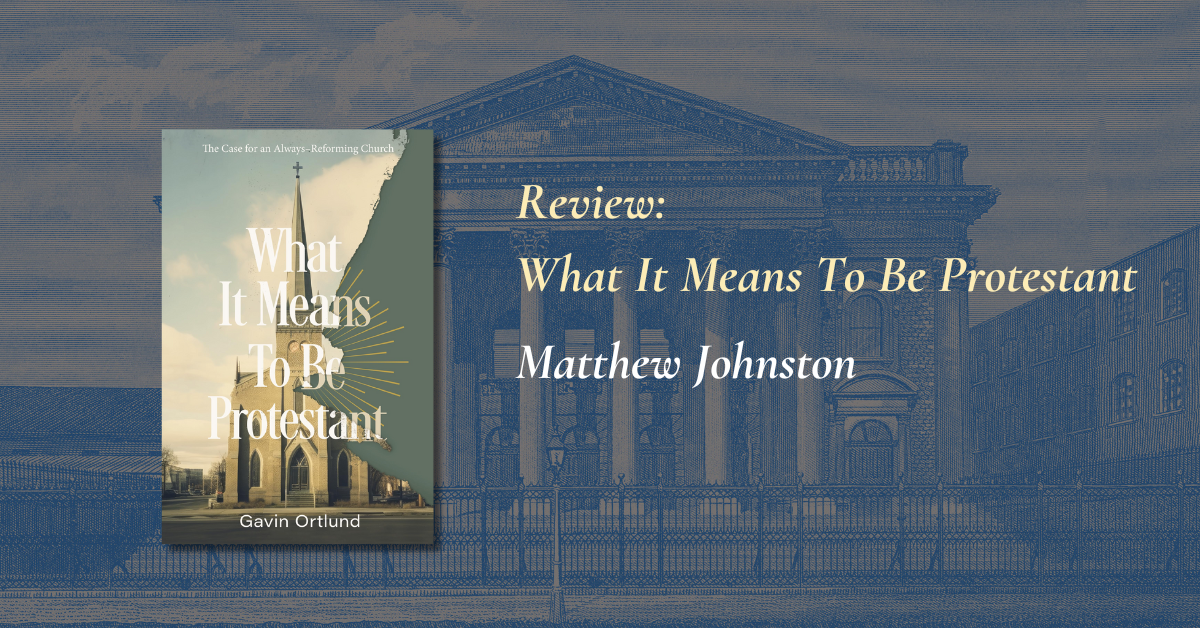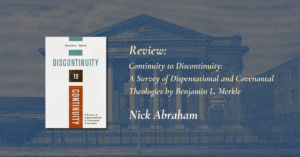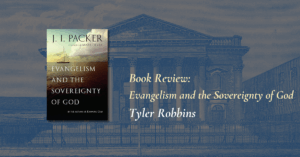Introduction
Conversations between Protestant and non-Protestant traditions often degenerate into little more than a clash of caricatures and a rehashing of underdeveloped arguments. Gavin Ortlund’s What It means to Be Protestant carefully avoids both pitfalls. Ortlund’s charitableness and willingness to seriously consider the other side’s arguments evidence that he has indeed learned to see Protestantism through non-Protestant eyes (xiv). He covers the classical terrain—the formal and the material causes of the Reformation, for example—but he does so with fresh insights and historical depth. Ortlund consistently makes a convincing case, carefully defining what is at stake, showing a conversance with the magisterial documents under critique, drawing from non-Protestant scholarship and arguing for modest, minimalist claims that are difficult to refute.
The best of what the book has to offer tackles two primary questions: “How should Protestants interact with non-Protestant traditions?” and “Why is Protestantism a better expression of true catholicity and biblical Christianity than non-Protestant traditions?” However, the book also deals with a third question: “How then should we assess non-Protestant traditions like Roman Catholicism?” That is to say, should Protestants consider them to be true churches? Ortlund’s handling of this third question raises a few concerns. Although these misgivings do not undermine the usefulness of Ortlund’s contributions to the first two questions, they are not unimportant. This review will first provide a largely appreciative overview of the book’s contents and then highlight two aspects of concern surrounding the third question.
Claiming Catholicity
Ortlund explains that the vision of Protestantism commended in the book is “not an unqualified rejection of the rest of the church, but rather a movement of renewal and reform within the church” (xix). This catholic (lowercase “c”) approach to Protestantism strengthens Ortlund’s case, giving it historical robustness while gaining a better hearing from non-Protestant traditions. Ortlund argues that, although non-Protestant traditions have not entirely lost the Gospel (they have “obscured” and “added on to” the Gospel), Protestantism “is best positioned to maintain a truly catholic vision of the church today amid its current fractures and divisions” (xxiii). Ortlund gives a twofold overview of the book:
In sum, I commend Protestantism as first, a renewal of the gospel in the church; second, a return to the authority of Scripture; and third, a removal of historical accretions. Or, stated in terms of negations: part 1 opposes the assertion that any one institutional hierarchy comprises the “one true church”; part 2 opposes claims that the postapostolic church can act infallibly; and part 3 opposes the sentiment that Protestantism is a departure from ancient Christianity (xx).
In Part 1 (chapters 1-4), Ortlund argues for the catholicity of Protestantism. Protestantism did not create a new church but rather labored as a renewal movement in the one true church (chapters 1-2). Abuses in the church made the Reformation’s recovery of sola fide necessary (chapters 3-4).
Chapter 1 expounds four principles of Mercersburg Theology, relying on Schaff’s lecture, The Principle of Protestantism to “highlight how Protestantism is well positioned to serve catholicity and renewal in the church” (5). Acknowledging blame on both sides in a divorce does not amount to an acknowledgement of 50/50 blame. In the same way, “a Protestant today can maintain that the Reformation was and is justified while also acknowledging various unfortunate tendencies that have characterized much of Protestantism in its overall development and current state” (9-10). The chapter concludes by invoking other Protestants (such as Luther and Calvin) to try and show that Schaff’s catholic vision of Protestantism was not unique.
Chapter 2 defends the classic protestant position on the distinction between the visible and the invisible church. Protestants do not deny the visibility of the church but only that visibility must not be determined institutionally. Ortlund explains, “What distinguishes the Protestant view of the church is not a denial of the visible church but rather the claim that this visible church coheres within multiple institutions. To put it negatively, Protestantism denies the claim that any one institutional hierarchy constitutes the ‘one true church’” (22). Whereas historically both the East and Rome have taught that salvation is limited by their institutions, “Protestantism is prepared to discern the true church wherever Christ is present in Word and Sacrament” (37).
Chapter 3 deals with the urgent need for reformation in the sixteenth century church by highlighting two catalysts: indulgences and persecution. Drawing on Catholic sources, Ortlund shows the dangers of indulgences and that they were a medieval development. He then describes how persecution squashed pre-Reformation attempts at reform, focusing primarily on Jan Hus. The problems in the church explain why a renewal movement necessarily had to take the form of protest (56).
The heart of the Reformation, sola fide, justification by faith alone, is taken up in chapter 4. The simple gospel that “We are made right with God simply by repenting and receiving the gospel” was “recaptured and recentered in the Protestant movement” (60). Ortlund believes that the Catholic and Protestant dialogue on justification “has made much progress since the Reformation” (60). However, he still sees “fundamental” differences in the two understandings of justification. Ortlund identifies the formal cause of justification as the key point of difference (62-63). Although Ortlund acknowledges the pertinence of the sacramental system when discussing Rome’s view of justification (63), a discussion on the instrumental cause of justification would have been helpful.
The second section (chapters 5-8) takes up the inevitable question of authority. Sola scriptura and the papacy each receive two chapters. Ortlund’s argument for a “modest” version of sola scriptura in chapter 5 is especially strong. He simply argues that the Scriptures are the only infallible authority. This means all other authorities (including the church), are fallible; they can err. His argument for sola scriptura stems from the uniqueness of Scripture: “I propose that sola Scriptura is the cumulative entailment of two considerations: (1) Scripture’s nature (what it is) and (2) Scripture’s role among God’s people (what it does)” (75-76). Chapter 6 deftly deals with common objections to sola scriptura. For example, Ortlund notes, “The simple fact is that it is not necessary to be infallible to discern that which is infallible” (89). He leans heavily on his knowledge of Augustine to show that the Protestant appeal to sola scriptura is not new (95-100).
In chapter 7, Ortlund lists three minimum entailments of the doctrine of the papacy: succession, infallibility, and primacy (104). Helpfully, he lets Rome’s magisterial pronouncements at Vatican I set the standard for the claim that must be defended. Since Rome declares that the institution of the papacy has always been present in the Catholic church, this claim can be defeated simply by proving its absence in the early church. By way of example:
Lumen Gentium, a dogmatic constitution promulgated at Vatican II, stipulates the role of the pope in relation to ecumenical councils: ‘It is prerogative of the Roman Pontiff to convoke these councils, to preside over them and to confirm them’ In contrast to this, none of the first seven ecumenical councils were convoked or presided over by a Roman bishop (rather, the emperor did so) (113).
Ortlund’s arguments—both biblical and historical—are carefully nuanced. Biblically, Peter had a “unique leadership role among the Apostles” but it falls short of what is envisioned by Vatican I (106). Historically, “…the early Roman church did enjoy a kind of primacy…The problem is that primacy doesn’t necessarily entail supremacy and infallibility, the specific qualities Vatican I asserted were characteristic of church history” (111). Similarly, chapter 8 acknowledges the general idea of apostolic succession but refutes the exclusivist version often appealed to by non-Protestant traditions. Apostolic succession cannot be conveyed by monepiscopacy because it was a gradual development as confirmed by the universal evidence of only two offices in the early church (125).
The third section (chapters 9-10) deals with history. First, Ortlund characterizes Protestantism as retrieval (chapter 9) and then offers a historical analysis of key doctrines that are present in non-Protestant traditions but absent in Protestantism: the assumption of Mary in Roman Catholicism (chapter 10) and the veneration of icons in (primarily) Eastern traditions (chapter 11). The Roman and the Eastern church obscures the gospel because of additions that slowly accrued over time (accretions). Protestantism too can have accretions. “The difference is that Protestant accretions are not enshrined within allegedly infallible teaching” (149).
Ortlund convincingly debunks Newman’s famous assertion: “to be deep in history is to cease to be Protestant” (136). Crucially, he distinguishes between two genres of historical depth: “majority depth” and “ancient depth” (150). Majority depth focuses on “what eventually becomes mainstream, widely accepted, or officially selected along the way of history” (150). In the ancient depth view “what is deepest is what is oldest and thereby most plausibly rooted in the first-century apostolic deposit” (150). Ortlund uses this apostolic (ancient) view of historical depth to show that the assumption of Mary and the veneration of icons should be considered accretions rather than catholic.
The thrust of the book’s argument is explained in the conclusion:
Protestantism is the most catholic and the most biblical of all the major streams of Christianity. For a Protestant need not believe in dogmas that seem obviously untruthful (like the assumption of Mary) or adhere to practices that seem obviously nonapostolic (like the veneration of icons)—but a Protestant also need not anathematize as unchristian those who inhabit traditions that do adhere to such beliefs and practices (the depth of Protestant concern about them notwithstanding) (221).
Questions about classification
What it Means to be Protestant levies devastating critiques against essential Roman Catholic doctrines. In light of these critiques, how is Rome best classified? The question regards the institution rather than individuals within her. The Protestant Reformers readily acknowledged that there are true believers within Rome. The question is about the status of the Roman Catholic communion. Can she be considered a true church? Ortlund answers in the affirmative, but I have some concerns about why he thinks so. Ortlund seems to have misread and therefore misused some key classical Protestant sources on the status of Rome. He also seems to have an underdeveloped doctrine of the marks of the true church.
Calvin and Turretin on Rome
In fairness to Ortlund, space constraints surely precluded extended interaction with Calvin and Turretin. Further, it can be readily admitted that assessing the truth or purity of churches is no easy task (see Bavinck, Reformed Dogmatics, 4:315-316). Nevertheless, it seems that Ortlund has misrepresented their positions. In some important ways Ortlund presents both Calvin and Turretin as saying a bit more and also a bit less than what they have written. Ortlund certainly does not have to articulate his assessment precisely the way these two Reformed theologians do. Yet if he does invoke them, it seems reasonable to insist he does so in a way that adequately expresses the nuance of their positions.
Ortlund notes that “…Calvin bewailed the rampant idolatry, superstition, and error in the Church of Rome in his day but then qualified his critique: ‘When we categorically deny to the papists the title of the church, we do not for this reason impugn the existence of churches among them.’”(15, from Institutes of the Christian Religion, 4.2.12). He goes on the explain that,
He [Calvin] compared these true churches to a scattered remnant, and the general status of the Church of Rome to a half-demolished building. These statements are representative of the general perspective of the magisterial Reformers—the Church of Rome had fallen into gross sin and error, but she was still a church (15-16).
Calvin does recognize the existence of churches within Rome but, as far as I can see, Calvin does not describe the remnant within Rome as true churches. The very next phrase in the section that Ortlund cites sems to underscore this distinction: “Rather, we are only contending about the true and lawful constitution of the church, required in the communion not only of the sacraments (which are the signs of profession) but also especially of doctrine” (4.2.12). Rome cannot simply and properly be considered a church because she is not a true and lawful expression of the marks of the church. Calvin argues that it is only the pure preaching of the Word “that can give the true meaning of the church” (4.2.4). Roman churches are not utterly dead because of the remnant of true believers within her and the vestiges of some of the marks of the church (4.2.11-12). Nonetheless, as the most important marks of the true church are all but erased, “every one of their congregations and their whole body lack the lawful form of the church” (4.2.12).
It could be that when Ortlund takes Calvin to affirm “true churches” within Rome, he intends “true” ontologically; they are not so false that a church cannot be said to exist in some sense. However, although Calvin does affirm as much, he does not use “true” the way Ortlund does. Calvin speaks of churches within Rome only in a qualified sense because a true church upholds sounds doctrine such that a Christian man must stand in full communion with her (4.10.10). For Calvin, true churches and the teaching of the truth go hand in hand:
If the foundation of the church is the teaching of the prophets and apostles, which bids believers entrust their salvation to Christ alone—then take away that teaching, and how will the building continue to stand? Therefore, the church must tumble down when that sum of religion dies which alone can sustain it. Again, if the true church is the pillar and foundation of truth [I Tim. 3:15], it is certain that no church can exist where lying and falsehood have gained sway…Since conditions are such under popery, one can understand how much of the church remains there. Instead of the ministry of the Word, a perverse government compounded of lies rules there, which partly extinguishes the pure light, partly chokes it. The foulest sacrilege has been introduced in place of the Lord’s Supper. The worship of God has been deformed by a diverse and unbearable mass of superstitions. Doctrine (apart from which Christianity cannot stand) has been entirely buried and driven out. (4.2.1-2).
Turretin is handled in similar fashion. Ortlund summarizes Turretin’s position as follows: “the Church of Rome is a true Christian church insofar as she has Christian people, Christian sacraments, and Christian doctrines” (16). However, it seems like Ortlund is saying something a bit stronger than Turretin, who introduces the three items Ortlund mention this way: “…it can still improperly and relatively be called a Christian church in a threefold respect” (Institutes of Elenctic Theology, 18.14.3). After listing the three items Turretin says, “But we deny that she can simply and properly be called a true church, much less the one and only catholic church, as they contend” (18.14.3). Turretin is working hard to avoid using the adjective “true” and only uses “Christian” with important caveats. That this is the case seems to be confirmed by the title of the question itself: “Can the church of Rome today be called a true church of Christ? We deny against the Romanists” (18.14.3). Furthermore, before giving eight extensive proofs as to why Rome is not a true church, Turretin says:
As therefore that can be called a true church which retains this foundation of salvation and whose doctrine exhibits these signs, so whatever church is destitute of them (such as we think the Roman to be), we rightly maintain cannot be called a true church (18.13.5).
I certainly don’t mean to belabor the point. However, it seems Ortlund makes Calvin and Turretin say both more and less than they really did. There is more at stake than a careful reading of historical sources. Missing this distinction between a true church and churches in other senses creates problems for the doctrine of the marks of the true church.
The marks of the true church
If I am reading him rightly, Ortlund seems to offer a simplified doctrine of the marks of the true church. Ortlund touches on the marks of the visible church on a few occasions: “By defining the church as wherever Christ is present in word and sacrament, Protestantism enables us to recognize true Christians and true churches within multiple institutional expressions of the church” (129, cf. 31 and 37). First, it is important to remember that the presence of true believers within an institution does not necessarily have a bearing on its status as true or false (see for example John Owen, Of Schism in Works, 13:154). Second, it seems that the classical articulations of the marks of the church are deliberately more specific than Ortlund. The Belgic Confession describes the first mark of a true church this way: “it engages in the pure preaching of the Gospel” and “governs itself according to the pure Word of God.” A false church, then, is one that “assigns more authority to itself and its ordinances than to the Word of God” (Belgic Confession Article 29, Van Dixhoorn, p. 102). According to this standard definition the fact that there are elements of the truth and of the Gospel in the Roman Catholic Church does not make her a true church.
Ortlund finds a principle for discerning the work of Christ in 1 Corinthians 12:3 which says “…no one can say, ‘Jesus is Lord,’ except by the Holy Spirit.” Ortlund explains that “we are commanded to discern the work of the Holy Spirit based on the fact that it results in an affirmation of the lordship of Christ” (36). He goes on to say that, “Both a Roman Catholic and a Calvinist could pass the test, but a Buddhist or a Mormon could not” (36). I suppose this is true as far as it goes but this does not help us discern a true church.
The clarity of Ortlund’s argument would have been helped by embracing Turretin’s distinction between the general and special marks of the church (Institutes of Elenctic Theology, 18.12.5). General marks like profession of the Lordship of Christ—or to use Turretin’s examples: profession of Christianity as outlined in the Apostle’s Creed and baptism—do not differentiate true churches from false churches. Rather, these general marks only show “in what manner a society of Christians can be distinguished from an assembly of pagans, Turks and other unbelievers” (18.12.5). The special marks of the true church have to do with the purity of the Word and sacraments. These marks are used to show how among “the various assemblies which profess the name of Christ, the true and orthodox can be distinguished from the false and heretical, which are unworthy of the name of the true church” (18.12.5). Protestants have need of both general and special marks if they are to adequately understand Roman Catholicism.
I hope Ortlund’s What it means to be Protestant continues to enjoy a wide readership. There is much to learn from the way Ortlund deals with the two primary questions: “How should Protestants interact with non-Protestant traditions?” and “Why is Protestantism a better expression of true catholicity and biblical Christianity than non-Protestant traditions?” I hope readers will reevaluate his approach to the third question: “How then should we assess non-Protestant traditions like Rome?”
Author
-

Matthew Johnston serves as a pastor at Lux Evangelica and the director of the Istituto Teologico Evangelico Verbum in Genoa, Italy. He is also a fellow of the Reformanda Initiative. He holds an MDiv from The Expositors Seminary and an MTh from the University of Glasgow, where he studied Christology in Robert Bellarmine and Francis Turretin. He is currently pursuing a PhD in historical theology at the Evangelische Theologische Faculteit, Leuven.
View all postsRecent Posts



